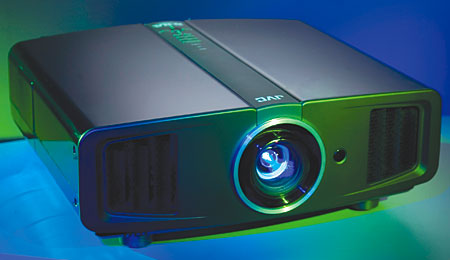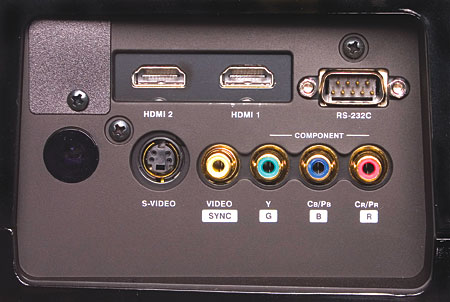JVC DLA-HD100 D-ILA Projector
In the quest for deeper blacks and ever better contrast-ratio specs, dynamic irises that close down and open up the projector's light output automatically depending on the program material are all the rage. But there's no free lunch here. While the best auto-iris designs deepen blacks and increase contrast and are invisible in operation, there are inevitable issues with the varying black levels and brightness compression involved in this sleight of hand.

With last year's DLA-HD1, improved light engines in JVC's D-ILA projectors achieved category- leading blacks and contrast ratio without the use of—or compromises involved with—an auto iris. Although the HD1 remains in the line, this year's follow-up is the more expensive DLA-HD100 ($7,999), which addresses some of the minor issues with last year's model and totally delivers the goods for immersive home theater impact.
Design—More of a Good Thing
The reasonably stylish casing looks similar to that of last year's model, but it's finished in all black, which will make owners of darkened ISF-approved bat caves happy. The open vents on either side of the lens are good in that this is a cool, quiet projector. It's not Sony quiet, but it didn't bother me an instant, even though it was stand-mounted within a couple of feet of my chair. Back in the day, there was a cottage industry of custom-built "hush boxes" for JVC's D-ILA projectors, but that isn't a viable business plan anymore.
The downside of the vents carried over from last year is light spill aimed right at the screen. There are diagonally placed fins behind the vents, but this projector still sprays enough light into the room to be distracting and lighten the black bars on a 2.35:1 movie.
Easing installation, there are manual adjustments for both vertical and horizontal lens shift. But zoom and focus are electronic and accessible via remote. It's handy for dialing in the tightest image to get your eyeballs close to the screen and adjust the focus in small increments. One nit here, though—when the focus adjustment is engaged, a gray graphic that says "Focus" covers the center of the screen, which ironically is what you want to look at when you're focusing the projector.

There are two HDMI 1.3 inputs and a component input. HDMI remains the best and worst thing that's ever happened. While everything was fine with the JVC and the Anthem AVM 50 pre/pro I've been using as a reference for months, it didn't work in conjunction with Integra's new DTC-9.8 pre/pro, which has HDMI 1.3 switching. There was no picture or sound with any sources. Oddly, when I switched the Integra's output from the JVC to the HDMI 1.2 Marantz VP-11S1 projector, it worked just fine. As usual with these broken HDMI marriages, it's hard to know which party is to blame, so I just reports what I sees and hears (or don't).
Another nifty carryover is the Pixel Adjust feature, which allows for horizontal and vertical adjustment of the projector's red, green, and blue chips. Alignment of three-chip projectors is critical for a tightly focused, sharp image. While this is excellent in theory, the one-pixel increments were so coarse—and the projector already so well converged—that the adjustments weren't useful. I guess if it really got jacked up in shipping, this could help.
Also, like the DLA-HD1, the DLA-HD100 accepts 1080p/24 sig- nals and displays them at 96 hertz with no 3:2 pulldown. And it displays 1080p/60 content at 120 Hz. The processing solution here is from Gennum, and it's terrific.
Get Up, Setup
The JVC has three preset Image Profiles of picture adjustments and three User settings that you can apply to any input once saved. There are also two memories for custom Color Temp settings that you can select for any Profile. The Color Temp adjustments don't offer controls for red, green, and blue at the top and bottom of the brightness range, which is odd for a projector of this pedigree. There is another adjustment in a different area of the menu called Offset, but it doesn't interact with Color Temp in a direct fashion. As a result, the gray scale doesn't track as tight as digital displays with full control over both ends of the scale, but it's acceptable. The Middle setting is the best of the stock options, but I'd still recommend an ISF calibration.
Gamma has four presets and a Custom curve that JVC explains very poorly and is thus best left alone. In any case, I used the Normal setting and never found any reason to deviate after some experimenting with the other choices.
There is also a Vertical Stretch mode that allows the HD100 to be used in conjunction with an anamorphic lens and 2.35:1 screen without the need for outboard processing.
HDMI Input Level setting allows the user to select an "Enhanced" setting for RGB signals from DVI sources. Since I used HDMI throughout this review, Normal was fine.
There is a High Lamp Power setting, but I never felt the need to use it. I got plenty of light output and punch on my 80-inch-wide Stewart Studiotek 130 screen (1.3-gain, white) with the Normal setting. Nice to know it can be goosed up if you need to go to 11 as the lamp ages, however.
Although the methodology of moving around in the menus is a bit more cumbersome than necessary, the remote control itself is excellent. It's backlit and has direct single-button-push access to all of the critical inputs and adjustments.
 Performing
Performing
Having a three-year-old and watching Pixar's Cars 125 times on Blu-ray has some advantages. When a new display comes in and Editor Jr. puts that sucker on, it's an instant reference. The JVC's formidable strengths and its few weaknesses were immediately on display. Lightning McQueen was just a smidge more orange than I'd like, and Chick Hicks a bit more yellow-green. Not cartoonish or genuinely weird, but still not as natural as I'd like. Backing down the color control a bit helped some, but it didn't entirely solve this issue.
But that's hardly the whole story. Cars on Blu-ray bounds with colorful detail. This three-chip projector was incredibly crisp and detailed, but it also had exceedingly natural dimensionality. There are many sequences in Cars that are reach-out-and-touch-it real. The very best single-chip DLPs I've seen are just a bit sharper, especially in the finest details. But the easy-on-the-eyes seamlessness, along with the outstanding blacks and contrast, produced a natural depth and solidity of image that I've not seen bettered by any 1080p projector.
Speaking of blacks and contrast, they're outstanding. This projector has the best and most natural balance of light output and deep blacks I've seen. It's bright enough to pop and even withstand some room light, but the blacks just don't suffer. This is the rare projector that has plenty of pop for watching the NFL playoffs in HD, without needing a different set of image adjustments when the lights go down and a movie starts.
Fox's Blu-ray release of Sunshine not only proved that the JVC's eye-popping detail isn't limited to animation, it also demonstrated its superiority to auto-iris designs. Shots of space trip up even the best auto irises, as the stars get noticeably dimmer as the iris closes to blacken up the space surrounding them. The JVC not only didn't have this issue, it also showed the ability to draw very subtle details near black, as demonstrated by the dark backside of the Icarus II as it pulls closer to the sun.
Alignment, sharpness, and white- and black-field uniformity issues have been known to plague three-chip designs in the past, but they weren't a factor here. The JVC backed up its impressive, subjective picture performance with some showy test results. It reproduced the highest frequencies in 1080 HD signals with the best of 'em, again with only the very best single-chip DLPs offering just a bit more resolution. It was not quite as refined with chroma bursts, and crosshatch patterns revealed color fringing at the sides of the image due to either chromatic aberration in the lenses or alignment of the three D-ILA panels or both. This softens the image some, but obviously not to a noticeable degree.
And the Gennum processing holds up its end, which is one of the reasons broadcast 1080i looks so good. It converts video-based 1080i extremely well, setting my Toshiba HD-A30 HD DVD player to 1080i. Both the Spears and Munsil test discs and chapter 7 of Mission: Impossible 3 revealed sure-footed detection and compensation for 3:2 pulldown in film-based 1080i material.
Occasionally, the JVC did reveal itself as more prone to showing large areas of solid colors and certain transitions with more banding than I see on the DLPs I've been watching lately. This means there were some noticeable lines of gradation where there should be smooth, natural contours. Animated titles show this more typically than others. This wasn't a genuine distraction, and not a deal-breaker by any stretch, but it was something I could see here and there.
The DLA-HD100 is quite a bit more expensive and perhaps only marginally better than its predecessor. I prefer more natural colors, but the JVC performs in state-of-the-art fashion in so many ways, and it just looks so damned good overall that I can't restrain myself on that basis. I've spent time with many of the best projectors available over the last several years, and this is unquestionably one of the most compelling I've seen at any price. Highly recommended.
Highlights
• Awesome blacks and contrast without an auto iris
• Seamless, natural, and highly detailed
• Excellent processing























































